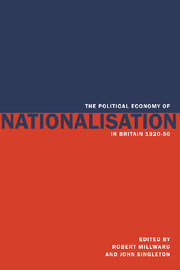Book contents
- Frontmatter
- Contents
- List of tables
- List of contributors
- Preface
- I Government and industry 1920–50
- II Case studies of industry organisation, performance and nationalisation
- III Government and the process of industrial change in the 1940s
- 11 ‘The Thin Edge of the Wedge?’: nationalisation and industrial structure during the Second World War
- 12 The political economy of nationalisation: the electricity industry
- 13 Partners and enemies: the government's decision to nationalise steel 1944–8
- IV Review and Conclusions
- Index
13 - Partners and enemies: the government's decision to nationalise steel 1944–8
Published online by Cambridge University Press: 07 May 2010
- Frontmatter
- Contents
- List of tables
- List of contributors
- Preface
- I Government and industry 1920–50
- II Case studies of industry organisation, performance and nationalisation
- III Government and the process of industrial change in the 1940s
- 11 ‘The Thin Edge of the Wedge?’: nationalisation and industrial structure during the Second World War
- 12 The political economy of nationalisation: the electricity industry
- 13 Partners and enemies: the government's decision to nationalise steel 1944–8
- IV Review and Conclusions
- Index
Summary
My aim is to discuss some of the issues arising out of the attempt by the first post-war Labour government to nationalise the steel industry. An important part in the process was played by the government's relationship with the industry's powerful trade association, the BISF. In fact, it will be argued that the government's initial hope was that nationalisation could be somehow carried out by consent with the industry. In the spring and summer of 1947 this led to protracted talks between Ministers and the leadership of the BISF on a possible compromise short of nationalisation.
Broadly the records confirm that nationalisation of steel was highly controversial inside the Attlee government and that the leadership would have probably dropped it, had they not been under pressure from members of the left both inside the Cabinet, among Labour backbenchers and in the trade unions. The difficulties in reaching a compromise, however, were not only of a political nature. Civil servants too found themselves at a loss when asked to consider alternatives such as extensive government shareholding, or a strong board capable of projecting a technocratic dimension. When the decision to proceed to full nationalisation was taken, the practical solutions to be adopted were again a subject of much discussion, given the complexity of the industry's structure.
Articulating the strategies: planners, corporatists, liberals
The discussion on the future of the steel industry gathered pace in the course of 1944, when the government's attention was being increasingly turned away from the day-to-day management of the war economy towards planning ahead for the post-war world (Hargreaves and Gowing 1952, chapter 23).
- Type
- Chapter
- Information
- The Political Economy of Nationalisation in Britain, 1920–1950 , pp. 275 - 306Publisher: Cambridge University PressPrint publication year: 1995



